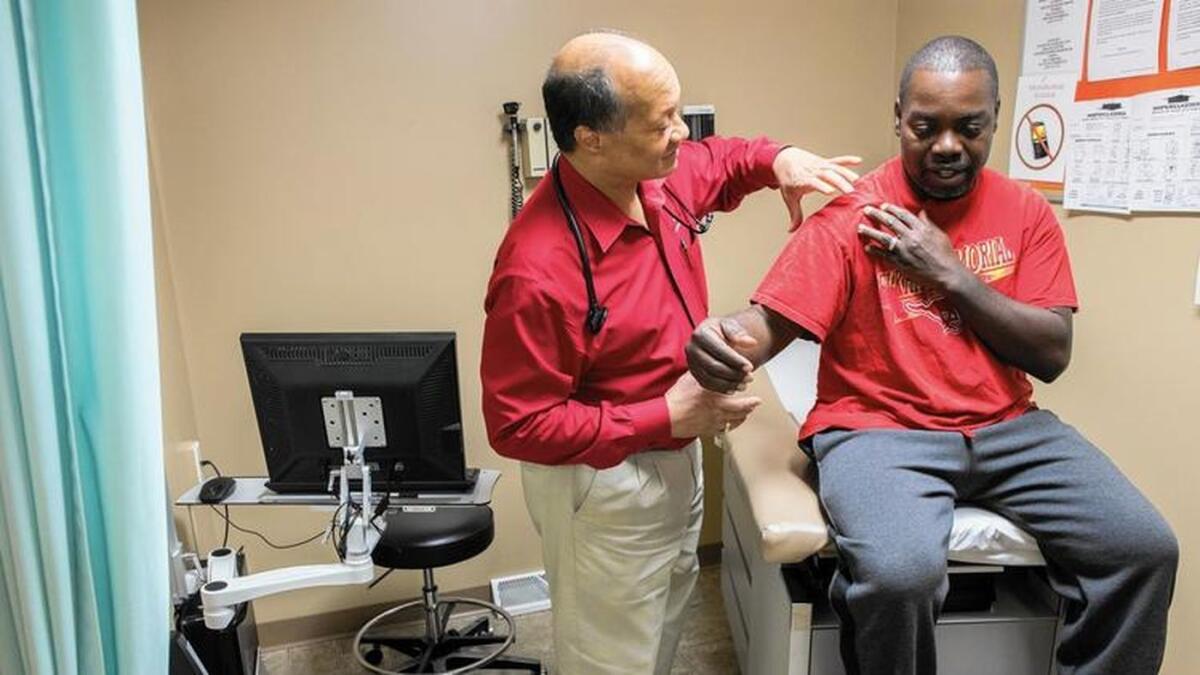Medicaid strategy favored by Trump may make care less affordable, new studies indicate

- Share via
Reporting from Washington — Even as the Trump administration pushes to make Medicaid enrollees pay a greater share of their healthcare costs, new research suggests this strategy may prevent many poor patients from getting needed care.
An independent study of Indiana, which has helped pioneer the strategy of charging Medicaid patients, identified lower rates of health coverage in the state than in neighboring states that do not impose the same costs.
And a second study of the state found that low-income Indiana residents have more problems paying medical bills and are more likely to delay care because of cost than in neighboring Ohio, which does not impose the same cost-sharing requirements.
“This may be circumstantial evidence,” noted Dr. Benjamin Sommers, a Harvard University researcher who co-authored the second study. “But there are certainly enough red flags to say that this approach may not be working the way it was intended.”
Both studies were published in the journal Health Affairs.
Indiana’s Medicaid program has been held up for years as a model by conservatives, who contend that charging poor people small premiums or fees for care – often called “skin in the game” -- engages patients in their health.
Seema Verma, whom President Trump tapped to oversee Medicare and Medicaid and who helped develop the Indiana program before coming to Washington, has encouraged other states to implement initiatives to place conditions on Medicaid coverage for able-bodied adults.
“Every American deserves the dignity and respect of high expectations,” Verma told a gathering of state Medicaid directors in Washington last year, in which she also endorsed efforts by some states to require Medicaid enrollees to work.
Verma declined through a spokeswoman at the Centers for Medicare and Medicaid Services to comment on the new Indiana research.
Indiana’s Medicaid strategy – known as the Health Indiana Plan, and later HIP 2.0 – imposes a complex series of cost-sharing requirements on patients in the program.
Patients must contribute to a health savings account used for their medical expenses. Monthly contributions, based on income, range from $1 to $30.
If patients make the contributions, medical care is essentially free. People can even lower their contributions by getting recommended preventive care, such as cancer screenings.
If patients don’t contribute, however, they lose dental and vision coverage and must make small copays when they see a doctor or fill a prescription.
For years, Indiana officials, including Verma, claimed that the strategy had broad participation from Medicaid enrollees.
But a growing body of evidence has shown that many Indiana enrollees do not make the required contributions.
One of the new studies, which was based on a survey of low-income adults in Indiana, Ohio and Kansas, found that only about a third of Indiana adults eligible for HIP 2.0 were contributing to the accounts.
About 31% of those who were not making the payments said they could not afford them; another 21% said they did not think the payments were worth it; and 19% said they were confused by the cost-sharing requirement.
At the same time, the researchers found that substantial numbers of low-income residents in Indiana reported trouble accessing care.
More than 30% reported that they delayed care because of cost, and 34% said they had trouble with medical bills.
In neighboring Ohio, by contrast, 25% of low-income residents said they delayed care, and 29% said they had trouble with medical bills.
Ohio, unlike Indiana, undertook a more traditional expansion of its Medicaid program that does not put the same cost-sharing requirements on poor patients.
Medicaid is available to residents making up to 138% of the federal poverty level, or about $16,700 a year.
The access problems in Indiana are also reflected in coverage numbers, according to the second study by researchers at Indiana University.
These researchers found that Indiana’s uninsured rate fell substantially after the state used HIP 2.0 to expand Medicaid through the Affordable Care Act.
But the state’s coverage gains were not as substantial as the gains in neighboring expansion states.
Seth Freedman, a health economist who co-authored the study, said the researchers could not say definitively that the cost-sharing requirements in Indiana explained the less robust coverage expansion.
But he noted that the findings suggest more research is needed. “There is a lot more to understand about these programs,” Freedman said.
Sommers, the author of the other study, cautioned: “We are in this new age of experimentation. This can be a good thing, so long as it is coupled with thoughtful, independent evaluation. But it doesn’t make sense to just scale up experiments just because they are the flavor of the month or because they are politically attractive.”
The Trump administration is moving forward rapidly to allow more states to impose cost-sharing or work requirements on Medicaid enrollees across the country.
But earlier this year, Verma scaled back the federal government’s plans to further evaluate the effect of Indiana’s program.
More stories from Noam N. Levey »
More to Read
Get the L.A. Times Politics newsletter
Deeply reported insights into legislation, politics and policy from Sacramento, Washington and beyond. In your inbox twice per week.
You may occasionally receive promotional content from the Los Angeles Times.











